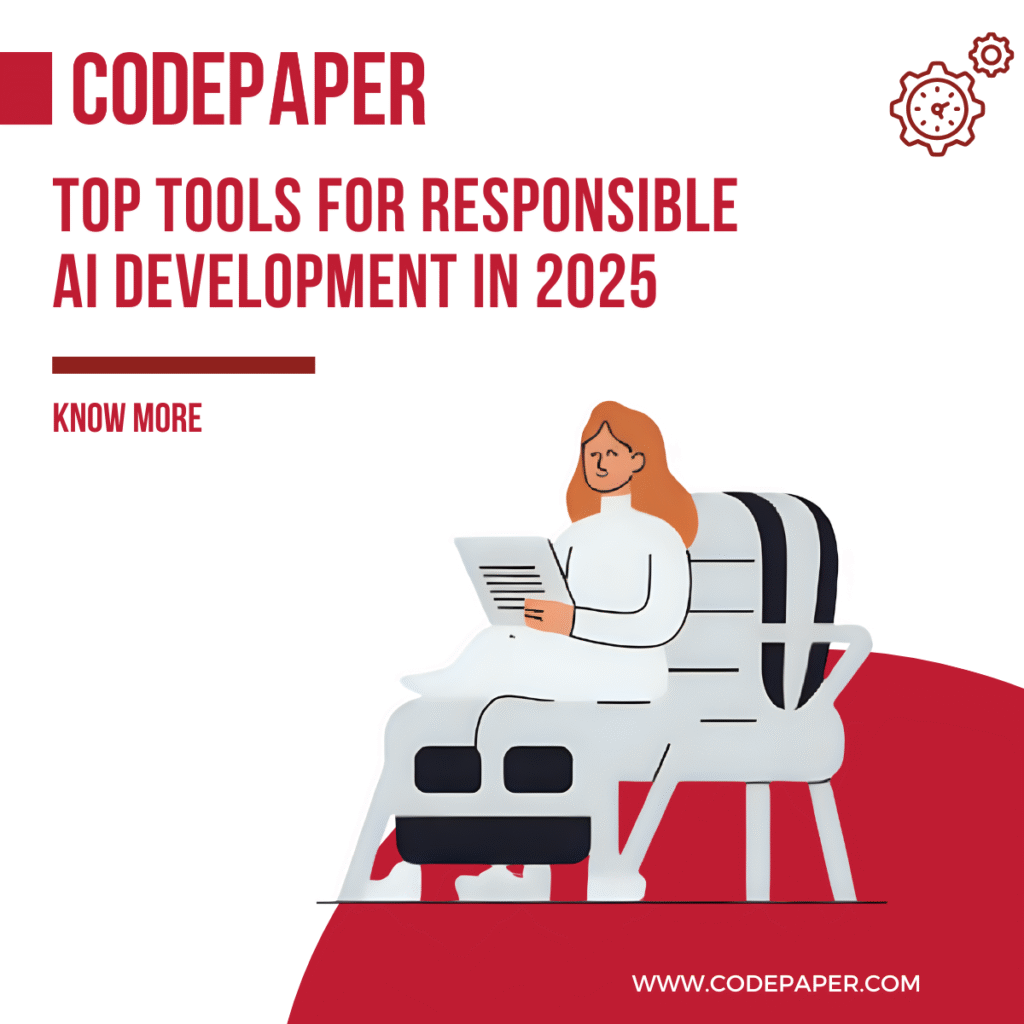Introduction: Why Responsible AI Matters More Than Ever
In 2025, artificial intelligence (AI) is embedded in nearly every business workflow—from customer service and healthcare diagnostics to financial approvals and recruitment. However, the trust placed in these intelligent systems is increasingly under scrutiny.
What happens when an AI system denies a loan unfairly, makes a biased hiring decision, or leaks sensitive user data?
Responsible AI development isn’t just a nice-to-have—it’s a business and legal imperative. To mitigate bias, ensure explainability, and stay compliant with global regulations like the EU AI Act, organizations must adopt responsible AI tools and practices proactively.

What Is Responsible AI Development?
Responsible AI refers to the design, development, deployment, and monitoring of AI systems that are:
- Fair and unbiased
- Transparent and explainable
- Secure and private
- Compliant with regulations
- Aligned with ethical principles and human values
This requires more than just good intentions—it demands a toolkit of powerful solutions that guide AI behavior, enforce governance, and make risks visible.
Why You Need Responsible AI Tools in 2025
Let’s face it—AI systems aren’t perfect. They’re trained on data that may carry historical biases, they’re often complex “black boxes,” and they don’t operate in a vacuum.
The consequences of neglecting responsible AI are very real:
- Business Risk: Inaccurate or unfair decisions lead to poor outcomes and lost revenue
- Reputational Damage: One biased AI headline can spark public outrage
- Compliance Penalties: Privacy laws like GDPR, CCPA, and the AI Act carry serious fines
- Automation Backlash: Customers may reject AI if it isn’t trustworthy
In short, you can’t scale AI without responsibility.
Top Tools for Responsible AI Development in 2025
Let’s explore the best-in-class tools that support key pillars of responsible AI—fairness, explainability, compliance, monitoring, and security.
1. Tools for AI Fairness and Bias Detection
IBM AI Fairness 360 (AIF360)
An open-source toolkit by IBM that helps detect and reduce bias in AI models.
- Evaluates fairness across demographic groups
- Multiple bias metrics (equal opportunity, disparate impact)
- Ideal for sectors like HR, credit scoring, and insurance
Fairlearn
A Python library that integrates easily with scikit-learn.
- Visualizes fairness trade-offs
- Optimizes models for equalized odds and demographic parity
- Useful in sensitive domains like hiring and education
Businesses looking to implement Fairlearn within custom platforms can explore custom software development in Canada for tailored, compliant solutions.
2. Tools for Explainable AI (XAI)
SHAP (Shapley Additive Explanations)
The industry standard for interpreting black-box models.
- Explains feature impact per prediction
- Visuals help teams understand model logic
- Works across tree-based and deep models
LIME (Local Interpretable Model-Agnostic Explanations)
- Lightweight, intuitive, model-agnostic
- Provides instance-level explanations
- Useful for building stakeholder trust
To learn more about explainable AI, Google’s Explainable AI Guide offers frameworks and tools supported by leading researchers.
3. AI Governance & Compliance Tools
Credo AI
A comprehensive AI governance platform.
- Scorecards for bias, risk, and ethical compliance
- Tracks model approvals and policies
- Aligns AI usage with the EU AI Act and internal policies
The European Commission’s AI Act overview outlines upcoming compliance mandates businesses must follow.
Monitaur
Real-time audit and compliance tracking.
- Logs decision-making
- Generates regulatory reports
- Works well for financial services and healthcare firms
For teams integrating Monitaur into enterprise systems, our AI consulting services provide expert implementation.
4. Monitoring and Auditing AI Models
Fiddler AI
Enterprise-grade model performance dashboard.
- Flags bias, drift, and compliance risks
- Real-time alerts
- Supports transparency at scale
WhyLabs
Focuses on data health and pipeline quality.
- Detects data quality issues
- Supports open-source frameworks
- Ideal for large-scale production systems
5. Tools for Secure and Responsible AI Pipelines
Microsoft Responsible AI Toolbox
- Centralizes fairness, explainability, privacy
- Works well with Azure services
- Open-source tools with community support
Google Vertex AI Monitoring
- Monitors AI deployments in Google Cloud
- Tracks model drift, performance issues
- Helps teams maintain compliant systems

How to Choose the Right Responsible AI Tools
Your selection depends on:
- Regulatory Pressure: Healthcare and finance demand high compliance
- Stakeholder Buy-in: Use interpretable tools if non-tech teams are involved
- Innovation vs Control: Choose flexible tools for early-stage startups, and stricter governance tools for enterprises
Implementing Tools with AI Governance Strategy
Responsible AI tools aren’t a patch—they should be part of your entire AI lifecycle, including:
- Data Collection – Bias detection starts here
- Model Training – Use SHAP, Fairlearn, and Credo AI
- Deployment – Enable monitoring with Fiddler or Vertex
- Post-Deployment Auditing – Use Monitaur or WhyLabs
- Documentation & Transparency – Maintain model cards and public disclosures
Scale your team with expert implementation using staff augmentation services.
FAQ
FAQs – Responsible AI Tools and Governance
Q1. What is responsible AI development?
Responsible AI is about building systems that align with human ethics, ensure fairness, maintain privacy, and stay compliant with laws like the GDPR and AI Act.
Q2. Which tools help prevent AI bias?
Use tools like IBM’s AIF360 and Fairlearn to detect and mitigate bias across demographic groups in your datasets and models.
Q3. What tools ensure AI compliance with laws?
Credo AI and Monitaur are widely used tools that track AI behavior and generate audit logs to satisfy legal and internal compliance needs.
Q4. How can I monitor AI systems after deployment?
Fiddler AI and WhyLabs provide real-time dashboards that monitor model performance, drift, and fairness over time.
Q5. Can I combine multiple responsible AI tools?
Absolutely. Combining tools like SHAP, Fiddler, and Credo AI provides full coverage—from fairness to explainability and governance.
